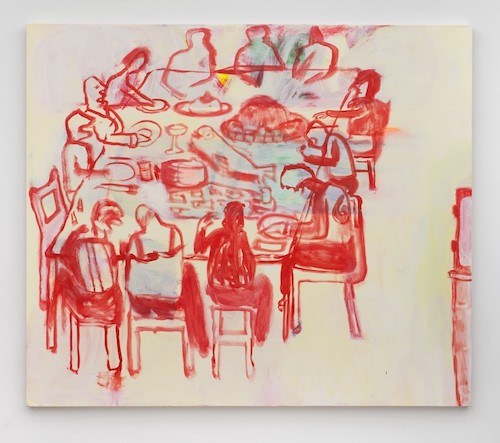Frye Favorites: Matthew Offenbacher
April, 2023
“How do you know when it’s done?” my painter friend asked, as we stopped in front of Katherine Bradford’s Lunch Painting the other day. It’s a question every painter knows well. In a lot of creative work like cooking meals, caring for loved ones, making conversation, etc., this question doesn’t come up because the work is never done. One meal leads to the next, one conversation to the next. In painting, however, the way Bradford does it, the work is defined by hard limits set by the painter, a kind of groping or scumbling towards edges and borders that, after a long struggle, lands at an ending. (Or doesn’t – failed paintings are legion.) A painting is done when it exudes an ineffable sense of balance, gravity, and authority. In Lunch Painting, however, doneness feels contingent, like a question, in a way that’s different from Bradford’s other paintings. This makes it my favorite in the show.
A cadmium red line sketches out twelve people sitting around a table, plus an empty chair. Anyone steeped in Western art history or Christianity will recognize the arithmetic of 12+1. If this is to be a Last Supper, however, where did Jesus go? It doesn’t seem to matter. Twelve people sit around a table set for a sumptuous, if odd, meal. Some are talking across each other, some intently focus on their plates. One person has a morsel balanced midway to their mouth. Two lean towards each other for a private conversation. I imagine the conversations as equal parts vicious gossip and boring blah blah, barbed and loving. Your typical family meal, wherever you find family.
The food is hard to make out. Some of it resembles disembodied breasts (cannibalism is also a Last Supper theme). Uneasily on the right edge sits an old TV set? microwave? mini-fridge? Little shards of color, yellow and green wedges, and submerged shadowy bodies remain from a painting that was started and then painted out. Centered, a fish gives you the fish-eye. Is this Bradford’s self-portrait? It reminds me of those court paintings where the royals’ pet dog stares knowingly out of the picture. The table is depicted as roughly the same size and dimensions as the canvas itself. Lunch Painting is a painting of lunch and painting as lunch, something to consume as we gather to gossip and enjoy each other.
I have a Night at the Museum fantasy about Lunch Painting. When the museum closes, the hardworking superwomen, ballerinas, and swimmers who maintain Bradford’s awkward compositions limp over to Lunch Painting to relax and refuel. One thing I love about Lunch Painting is that it rejects the savior narrative of Night at the Museum. The messiah has stepped away; we only have each other. Philosopher Olúfẹmi O. Táíwò writes that the strategy of giving people who have been historically excluded from places of power “a seat at the table” will not be sufficient for justice and social change. We need new chairs, new tables, he says, we must “build and rebuild rooms rather than regulate traffic between them.”
Maybe because this week is Passover, I’m thinking now that the empty chair doesn’t belong to Jesus after all, but to Elijah. Elijah, the prophet of undoneness. His story goes something like this: Elijah was a little too zealous in his prophesying, and so he was recalled to the heavens. He is the only prophet who never dies. As a result, he’s stuck wandering the world waiting around for his job at the end of time, which is to ride into Jerusalem on a donkey blowing a shofar to herald the end of days. Many synagogues set aside an empty chair for Elijah, and during the Passover seder we pour an extra glass of wine and open the door to invite him in. In folktales, Elijah plays many roles, as storyteller Peninnah Schram writes, “of mediator, matchmaker, opener of possibilities, rescuer, teacher or fairy godfather, all of which serves to restore hope.” What’s at stake for me in Lunch Painting is not what happens at the end, be it disaster or redemption, but what we can do in the meanwhile.
—Matthew Offenbacher, artist
 Katherine Bradford. Lunch Painting, 2018. Acrylic on canvas. 68 x 80 in. Collection of Edwin Oostmeijer, Amsterdam, The Netherlands. © Katherine Bradford. Image courtesy of Joe DeNardo
Katherine Bradford. Lunch Painting, 2018. Acrylic on canvas. 68 x 80 in. Collection of Edwin Oostmeijer, Amsterdam, The Netherlands. © Katherine Bradford. Image courtesy of Joe DeNardo